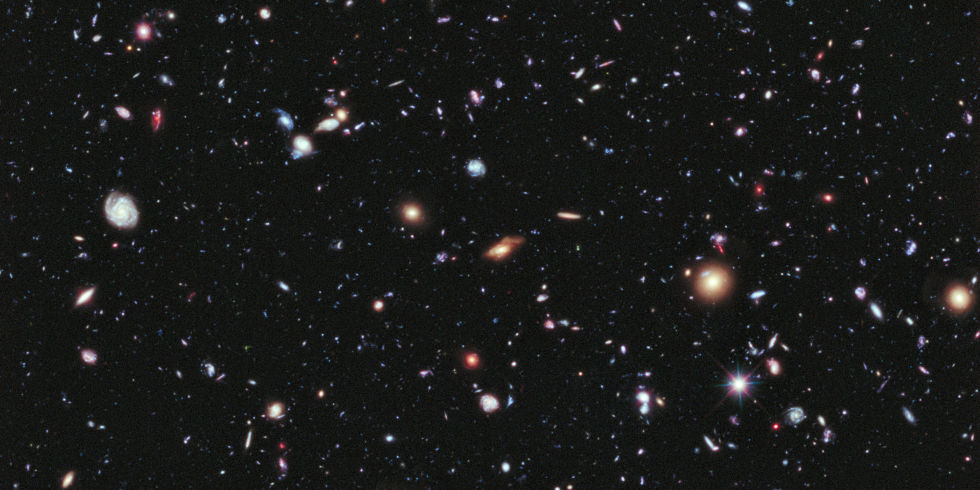In the foreseeable part of the universe, there are 10–20 times more galaxies than previously thought.

Picture taken by the Hubble telescope (Source: NASA / ESA)
The Hubble telescope helped astronomers make an interesting discovery that could have an impact on the entire future of astronomical science. As it turned out, in the observable part of the Universe there are 10–20 times more galaxies than scientists had previously believed. Such a conclusion was made after analyzing a large number of photographs of deep space, sent to Earth by the Hubble telescope. In the course of the work, scientists studied other images taken by astronomers at observatories on Earth.
The conclusion that in the Universe there are more galaxies than people believed until now was made by scientists from the University of Nottingham, led by Christopher Conselice. Most of these galaxies (about 90%) are relatively small and dim, so it is not so easy to notice them. According to scientists, such galaxies are like satellites of the Milky Way. “We missed the vast majority of galaxies because they are too dim and very far away,” says Professor Conselis.
“The real number of galaxies in the Universe is one of the fundamental issues in astronomy, and the fact that more than 90% of galaxies have not yet been studied is scary. Who knows what interesting properties of these objects we will discover when we start exploring galaxies with the help of telescopes of a new generation? ”The scientist asks.
')
The video posted above is Karl Sagan's performance at school, where he explains to students the immensity of the universe. “In total here (in the observable part of the Universe) there are about 100 billion other galaxies, each of which has about 100 billion stars. Imagine how many stars, planets and life forms can be in this huge and amazing universe, ” says Sagan.
The Hubble Orbital Telescope helps specialists explore the visible part of the universe. It has been operating for about 20 years, and for all this time, Earth scientists have obtained a huge amount of crucial information, including data on the number of galaxies in the Universe. Previously it was believed that in the foreseeable part of the universe there are 100–200 billion galaxies. But it seems that this number can be safely multiplied by 10 or even 20.
To count galaxies in the Universe is not an easy task. First, as mentioned above, we do not see most of these objects due to their dullness and small size. The problem, in fact, is not in the galaxies, but in the fact that the equipment used by man to observe them is imperfect. Secondly, for the time being we are able to study only a fraction of the space that is available for observation. Images of Hubble Deep Field are just one millionth of what a person could observe. Here is an animation that shows how krshechna area of space, for which Hubble observes.
Scientists from the University of Nottingham made their conclusions after analyzing the Hubble images for 15 years. The work was initiated by graduate student Aaron Wilkinson, who received a large grant for a project on counting galaxies. The data he received served as the basis for a much larger study conducted by Professor Conselis along with colleagues from Edinburgh and Leiden universities. They used Wilkinson data, images taken by Hubble, as well as images from other observatories from around the world. Mathematical analysis showed that the density of the "population" of the universe is higher than it was thought.
In addition, scientists have tried to calculate the number of galaxies in the ancient universe, billions of years ago. In their opinion, there were even more galaxies in the past than they are now — at least ten times.
“We know that since its appearance, the galaxy has evolved, merged with other objects, increased in size. The fact that there were more galaxies in the past indicates a very active evolutionary process that led to the merging of many systems, ”the scientists said in a statement. This evolutionary process is the merging of smaller galaxies into larger objects. New data will help scientists form a more accurate than ever model of the evolution of the universe.
Scientists, talking about a large number of galaxies in the universe, recalled the Olbers paradox . This is one of the paradoxes of pre-relativistic cosmology, which consists in the fact that in a stationary Universe uniformly filled with stars (as it was then thought), the sky (including night) should be approximately equal to the brightness of the solar disk. In theory, in the cosmological model of the Big Bang, this paradox is completely resolved by taking into account the finite speed of light and the finite age of the Universe.

Why is our sky at night dark and not glow? We could observe about such a picture if the Universe were static (source: Wikipedia)
This view is supported by experts from the University of Nottingham. They believe that with such a density of galaxies in the Universe, anywhere in the sky of the Earth, one can observe a galaxy. But the light from these objects does not reach us for several reasons - the expansion of the Universe, clouds of cosmic dust and gas, and other factors.
As for the number of galaxies in the universe, the calculations are still ongoing. It is not easy to do this work, so it will take astronomers a long time to build a more accurate model of the universe.
Source: https://habr.com/ru/post/369769/
All Articles